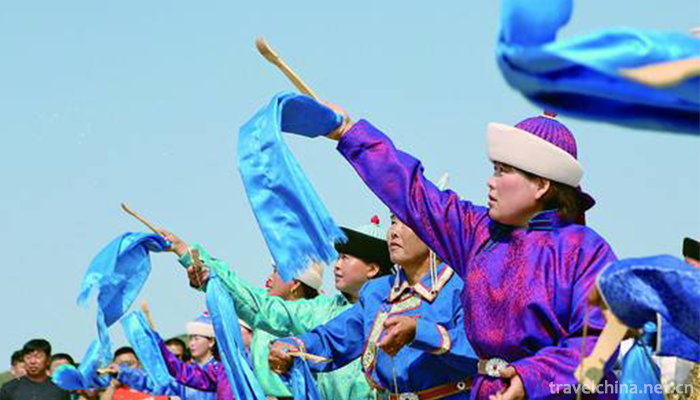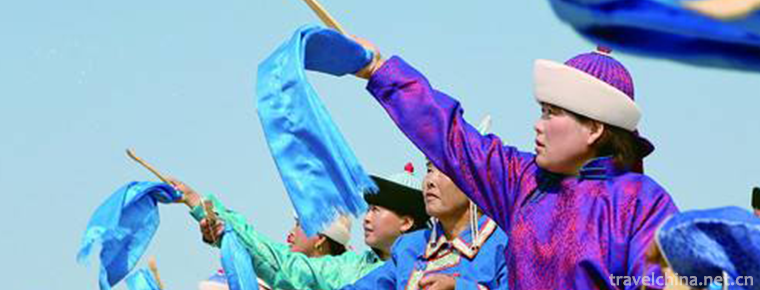Bogda Ula Festival
Bogda Ula Festival
The sacrifice of Bogdahura (Shenshan) is one of the earliest forms of Mongolian creative culture in China. It is the product of national culture, which is formed by historical accumulation and pluralism. It studies the special system of Mongolian folklore in a comprehensive and multidisciplinary way. The basic judgment is that sacrificial activities prevailed in Zalaite Banner during Tang, Song and Yuan Dynasties, especially after Shamanism was introduced into other places, and integrated with local customs to form a historical national cultural achievement. Although historical records are not fully recorded, historians believe that Zalai Banner was a historical national cultural achievement. The sacrifice to the God hill of Laite is another monument of Chinese folk culture. It can be seen from the origin of the sacrificial form of mountain names, the statues of God hills, the scriptures of God hills, the carols of God hills, the matching Nadamu congress, economic and trade exchanges and other relics. What a magnificent sacrifice to Bogdahura (god hill) was at that time! Its comprehensive Mongolian culture has a clear skeleton and a long history of inheritance. The sacrificial activities of Bogdahura (Shenshan) created by the Mongolian people have passed down from generation to generation in Zalaite, and become more and more solemn. The more formal the theme, the more three-dimensional development. However, because the sacrifice of Shenshan has been spread and presided over in Mongolian, there is no chance to translate into Chinese and English, so it has a serious closed impact at home and abroad. By the late 1950s, scholars and famous literary figures in Inner Mongolia, such as Jinfeng, Liu Yingman, Zhou Juxia and Liu Shaohua, publicly published the sacrifice of Shenshan in books and periodicals. In the 1960s, it aroused the attention of the leaders of Inner Mongolia Autonomous Region and people with lofty ideals from all walks of life. When Chairman Buch visited, he also came to Zalaite to mention the sacrifice of Shenshan, which aroused the attention of Comrade Bao Junchen, Vice-Chairman of the Political Consultative Conference of Inner Mongolia Autonomous Region. After that, the major TV stations recorded and broadcast the contents and procedures of the sacrifice of Shenshan from different perspectives, forming documentary prose and academic papers. Relevant materials such as "Environmental Protection Textbook" of Fang Party Course. A set of books and magazines on Bogda Ula (Shenshan) sacrificial culture will be published to recommend sacrificial activities, which will cause scholars at home and abroad to discuss Bogda Ula (Shenshan) sacrifice as a result of Mongolian and Yuan culture, and write a historical chapter with their own characteristics.
Zalaite Bogdahura (Shenshan) sacrifice has a long history, unique form, content and scriptures of Shenshan, and there are absolutely no mountain gods. In sacrificial activities, the time, place and preparation of sacrificial offerings are notified by the Yamen, and sacrificial offerings are held. The Lord sings the song "Ode to Ketuura in Uliji Chao" in Mongolian, invites the living Buddha to recite sutras, and then holds the Nadamu congress, trade material exchange and performing traditional Mongolian songs and dances, which are matched with the sacrificial offerings. It is said that the sacrifice of Bogdahura (Shenshan) is held from May 21 to May 23 of the lunar calendar every year, and the sacrificial activities are solemn and unique. Location: Bogda Ura Heimaurihada (Shenshan). 1. Pre-sacrificial preparation: First, the Qiyamen Damule (presided over) announces the date and place of sacrifice, accepts incense, food, wine and other personal apportionment items from each Nutuk; the task of Harule is to make a seven-day tour of the mountains, punished by hunters and fellers. 2. Scale: Each Nutuk arrives one day ahead of the sacrificial time and gathers at the south foot of Shenshan Mountain. In the center is the Mongolian yurt group of Qiwang Ye and his family, on the right is the Mongolian yurt group of Yamen officials and living Buddhas, doctors and businessmen, and on the left is the Mongolian yurt group of grass-roots officials and ordinary people in Konutuk. 3. Procedures, sacrificial offerings and other preparations: regularly carry Lama's drums, trumpets and other magic instruments and sacrificial offerings such as sheep and wine to designated sacrificial sites in Shenshan. 4. Decoration of Obo: Damuler's will, with decorations, began to decorate Obo in Black Maurihada, hanging picking banners or cloth strips around Obo, placing yellow cloth on a large strip of slate, placing dozens of bowls filled with water, wine and offerings, placing the rear feet of sheep and cattle, etc. In the south side of Obo, a white Jade statue of the Han Dynasty and several large-character banners of "Mountain God Sacrifice" were erected. 。 5. Lamas chant scriptures: In the past, the main character of Aobao was Lamas. After all the offerings were put on display, dozens of lamas sat in front of Aobao with cockcrown caps and robes. They recited the scriptures of God. When the big lamas waved Ling in their hands and lifted the macaroni in their other hands, bronze trumpets rang through the valley. 6. Pointing to the mountain gods: After the Lama recited the sutras, the Lord Master Mahbatu of Zazakh Belle took the lead in kneeling to Obo, and Master Ruben gave the pilgrims a motto ceremony, and waited for Adis to be accepted. 7. Giving Adis: Han means food cleansed by mana through Buddhist sutras. Several etiquette officers sprinkled manna around Obo. It was said that eating the Adis would bring good luck. 8. Convening the Obo Conference: The people who attended the sacrifices came down from the mountains and returned to the Mongolian yurts, and then began the Obo Conference. Presided over by Prince Marenshbatu of Zazakhstan, this paper mainly discussed the topic of how to protect the ecological environment of Shenshan and how to protect the sacrificial activities of Bogdahura (Shenshan). Punishment for deforestation of hunters. 9. Entertainment banquet: Damule and Harule add wine and meat to everyone. People sing and dance. Lamas perform Chama dances. Everyone sings the song "Ode to Uliji Chao Ketuura". The atmosphere was very warm and high. 10. Nadamu: It is the Mongolian horse racing, archery and wrestling matched with the sacrificial activities. 11. Bogdahura (Shenshan) sacrifice brings in traders from inside and outside the banner for trade exchanges, such as sheepskin, fungus, local products, cattle, sheep and other trading activities. To sum up, year after year, the inheritance and development of Mongolian cultural system, in addition to its own characteristics, promote national unity and improve the quality of the development of Zalaite harmonious society.


-
1.Slender West Lake
Slender West Lake, formerly known as Guarantee Lake, is located in the northwest suburb of Yangzhou City, Jiangsu Province
Time 2018-12-06 -
2.Jinan World First Spring Scenic Area
Jinan World No. 1 Spring Scenic Area, located in the center of Jinan City, Shandong Province, is a national AAAAA-level tourist attraction, national key park, advanced unit of national spiritual civil
Time 2018-12-08 -
3.Yunpu Dongtian Tourist Area
Yimeng Yunpu Cave Tianshan Scenic Area is located in Feixian County, Shandong Province. There are five scenic spots: Tour Stone, Tianmeng Lake, Drunken Stone Forest
Time 2018-12-22 -
4.Jiangshan Peninsula Tourist Resort
Jiangshan Peninsula Tourist Resort is a provincial tourism resort development zone approved by the People's Government of Guangxi Zhuang Autonomous Region in 1994.
Time 2019-01-21 -
5.Liaoheyuan National Forest Park
Liaoheyuan National Forest Park is located in Dawopu Forest Farm, Pingquan County, Hebei Province. It is named for its birthplace of Liaohe River in China.
Time 2019-01-30 -
6.Flower Huaer
"Huaer" is a folk song created and shared by Han, Hui, Tibetan, Dongxiang, Baoan, Sarah, Tu, Yugu and Mongolian nationalities in Gansu, Qinghai and Ningxia provinces in Northwest China.
Time 2019-05-04 -
7.Burning Techniques of Linqing Gong Bricks
Linqing fired tribute brick is an ancient handicraft. Beginning in the early Ming Dynasty, Yongle's firing technology is the unique experience accumulated by the working people in Linqing of Shandong
Time 2019-05-13 -
8.Wooden drum
During the performance of the wooden drum, one person holds the wooden board in his left hand and the drum in his right hand, beating the wooden board and the book drum in turn in standing rap to matc
Time 2019-06-05 -
9.Kimchi Making Skills Korean Kimchi Making Skills
Kimchi of Korean nationality is one of the traditional food with the most national characteristics of Korean nationality, and its pickling method is constantly enriched and developed. In the long hist
Time 2019-06-09 -
10.Ceramic microbooks
Ceramic micro-calligraphy is one of the folk skills which perfectly combines Chinese calligraphy art with color porcelain art. It has a long history. Artists not only maintain the traditional style, b
Time 2019-06-18 -
11.Hefei University Of Technology
HeFei University of Technology (Hefei University of Technology) is directly under the Ministry of education of People's Republic of China. National Key Universities By Ministry of Education , Anhui Pr
Time 2019-11-11 -
12.Neijiang scenic spot
Daqianyuan scenic spot is located in Yuanding mountain, Dongtong Road, Neijiang City, Sichuan Province. It integrates Zhang Daqian memorial hall, Zhang Daqian Museum, Zhang Daqian Art Museum, Zhang Daqian's former residence, Xilin temple, Lulan cave cliff tombs,
Time 2020-12-16